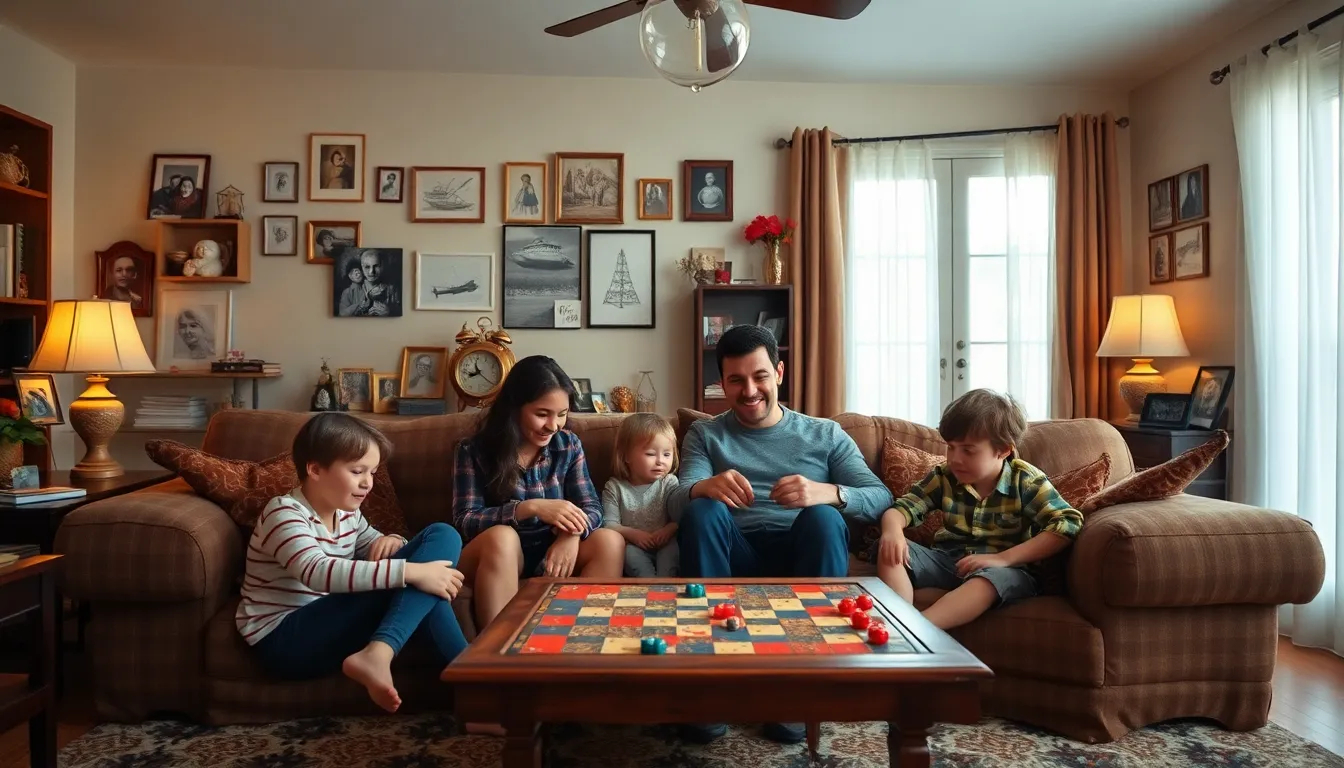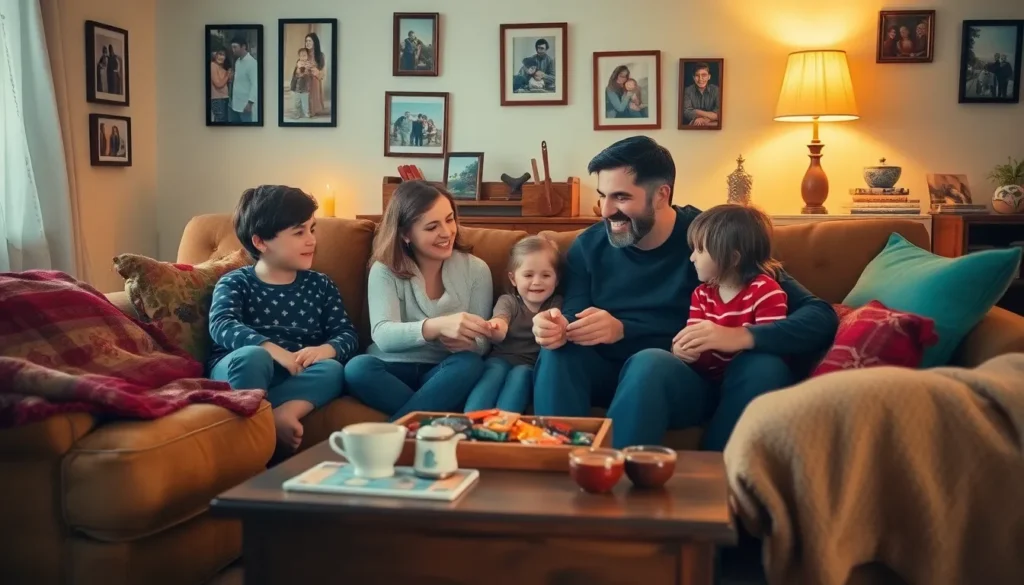Table of Contents
ToggleIn a world where everyone seems glued to their screens, creating inviting family spaces is more important than ever. These areas serve as the heart of the home, where laughter echoes and memories are made—often over a chaotic game night or a questionable culinary experiment. It’s not just about having a couch that fits; it’s about crafting an environment that encourages connection and fun.
Overview of Family Spaces
Family spaces serve as vital areas for interaction and connection. These environments encourage shared experiences, enhancing relationships among family members. Designing such spaces requires thoughtful planning, focusing on comfort and functionality.
Creating inviting areas involves considering furniture arrangements, lighting, and decor. Comfortable seating options promote relaxation, while warm lighting fosters a cozy atmosphere. Utilizing multi-functional furniture maximizes space and supports diverse activities.
Different family spaces can include living rooms, kitchens, and outdoor areas. Living rooms often serve as a central hub for gatherings, playing games, or watching movies. Kitchens facilitate cooking together, promoting teamwork and bonding during meal preparation.
Outdoor spaces represent another opportunity for family connection. Patios or gardens offer settings for barbecues or family gatherings, allowing for fresh air and natural surroundings. Designing these areas with seating, shade, and play equipment encourages outdoor activities.
Incorporating personal touches enhances the warmth of family spaces. Family photos, artwork, and unique decor reflect individual personalities while creating a sense of belonging. Ensuring that spaces adapt to changing needs increases their value over time.
Promoting interaction is crucial in family spaces. Engaging activities, such as board games or cooking sessions, foster communication and strengthen bonds. Prioritizing these experiences makes family spaces essential for nurturing relationships in today’s increasingly digital world.
Importance of Family Spaces

Family spaces play a crucial role in nurturing connections among family members. They foster environments where memorable moments and experiences can happen.
Promoting Family Bonding
Engaging activities bring family members together, strengthening bonds. Game nights, movie marathons, or collaborative cooking sessions encourage participation and teamwork. Living rooms serve as natural gathering points, making shared experiences memorable. Kitchens foster collaboration, where preparing meals becomes a fun family affair. Outdoor spaces like decks or backyards allow for picnics and barbecues, enriching family relationships. Personal touches enhance these spaces, creating a sense of belonging and connection.
Enhancing Mental Well-being
Family spaces contribute significantly to mental well-being. Warm atmospheres reduce stress and promote relaxation. Time spent together in these environments allows for open conversation, offering a support system for each member. Engaging in shared activities provides a break from screens, encouraging healthier interactions. Safe and inviting spaces facilitate emotional expression, vital for nurturing positive mental health. Overall, enjoying quality time within family areas enhances overall happiness and fulfillment.
Types of Family Spaces
Family spaces can be categorized into indoor and outdoor areas, each playing a significant role in promoting connection and interaction among family members.
Indoor Family Spaces
Indoor family spaces include living rooms, kitchens, and dining areas, each designed to facilitate interaction. Living rooms provide a comfortable environment for gatherings, whether it’s for movie nights or informal discussions. Kitchens invite collaboration during meal preparation, encouraging teamwork and communication. Dining spaces serve as locations for sharing meals, where conversations flourish around the table. Utilizing multi-functional furniture enhances flexibility, allowing families to adapt their spaces for various activities. Warm lighting contributes to a cozy atmosphere, making indoor family spaces inviting and engaging.
Outdoor Family Spaces
Outdoor family spaces such as patios, gardens, and backyards offer opportunities for connection in a natural setting. Patios serve as venues for barbecues and social gatherings, promoting outdoor dining and relaxed interaction. Gardens encourage family members to engage in activities like gardening or playing games together, reinforcing teamwork. Backyards provide ample space for children to play while adults connect over conversations. Incorporating seating and decorative features enhances the overall experience, creating inviting outdoor environments. These spaces allow families to bond, explore, and enjoy each other’s company in a refreshing atmosphere.
Designing Effective Family Spaces
Designing effective family spaces involves thoughtful consideration of various factors. Spaces must encourage connection while accommodating the diverse activities family members enjoy.
Consideration of Space Utilization
Utilization of space directly impacts the functionality of family areas. Practical layouts ensure comfortable movement, fostering interaction. Arranging seating clusters promotes engagement during conversations and activities. Multi-functional furniture, such as storage ottomans or expandable tables, optimizes space for gatherings. Effective use of vertical storage creates an organized environment without compromising floor space. Clear pathways enhance accessibility, making it easy for family members to transition between activities. Integration of natural light throughout boosts mood and energizes the atmosphere.
Incorporating Family Preferences
Incorporation of family preferences shapes inviting environments. Unique tastes inform color schemes, furniture styles, and decor choices. Engaging family members in the design process encourages ownership of the space. Selecting activities that resonate with everyone, like game nights or cooking sessions, ties the design elements together. Prioritizing comfort in furniture selection enhances the overall user experience. Considering hobbies, such as crafting or reading, tailors spaces to individual interests. Ultimately, embracing personal touches, like artwork or treasured memorabilia, creates a warm atmosphere where family bonds flourish.
Challenges in Family Spaces
Creating family spaces comes with numerous challenges. Space limitations often restrict the ability to design areas conducive to interaction. Many families struggle with furniture arrangements that prioritize comfort and functionality while addressing diverse needs.
Communication barriers can also arise, making it difficult for family members to connect meaningfully in these environments. Noise distractions from the external environment or internal devices disrupt conversations, reducing opportunities for engagement. Finding the right balance between privacy and shared space enhances interaction.
Additionally, maintaining organization and clarity in family spaces is essential. Clutter can lead to feelings of chaos and overwhelm, detracting from the warmth these areas are meant to provide. Prioritizing organization through effective storage solutions contributes to a more inviting atmosphere.
Personal preferences further complicate the design of these spaces. Family members may have differing opinions on colors, styles, and decor which can create tension during the planning stages. Encouraging open discussions about preferences fosters a sense of belonging and respect.
Budget constraints represent another significant challenge when designing family spaces. Many families must find cost-effective solutions that meet their needs without compromising on aesthetics or comfort. Implementing multi-functional furniture serves as a practical approach to maximize limited resources.
Addressing these challenges requires careful planning and collaboration. Involving all family members in discussions can lead to spaces that reflect individual tastes while promoting connection. Allocating time to analyze both problems and potential solutions ensures a balanced and enjoyable family atmosphere.
Creating inviting family spaces is essential in today’s digital age. These areas not only foster connection but also enhance relationships through shared experiences. By thoughtfully designing environments that prioritize comfort and functionality, families can enjoy quality time together.
Incorporating personal touches and engaging family members in the design process further enriches these spaces. Despite challenges like space limitations and differing preferences, collaboration can lead to effective solutions. Ultimately, the right family space encourages interaction and nurtures bonds, contributing to overall happiness and well-being.







